Video is dominating the internet
A look at digital video trends, OTT services and video ads.
In 1979 video killed the radio star.
Fast forward 40 years later to 2019 and video is continuing along with its massacre.
Who's the new victim?
Traditional TV, which is being killed off by online streaming services and OTT products.
According to eMarketer's digital video trends Q1 2019 report released last week, more and more American adults are streaming videos online and subscribing to OTT services.
In the process they are abandoning traditional TV subscriptions as the internet takes over as the prime medium for video.
Video ad spend on the rise
In particular, eMarketer's report found that nearly 83% of US internet users are video viewers, or 235 million, half of which watch live streams online using OTT services.
Secondly, video ad spend is growing rapidly, forcing eMArketer to revise its forecast upwards for video ad spend. As they themselves put it:
"Video and TV ad spending are both outperforming our expectations. We raised our forecast of video spending based on strength across the ecosystem - from mobile to connected TV to social media, and more. And TV ad spending closed 2018 with a net gain, contrary to our previous expectations of a slight loss."
At the same time, digital video continues to grow at much faster rates than TV ad spending, with the two set to converge after 2023.
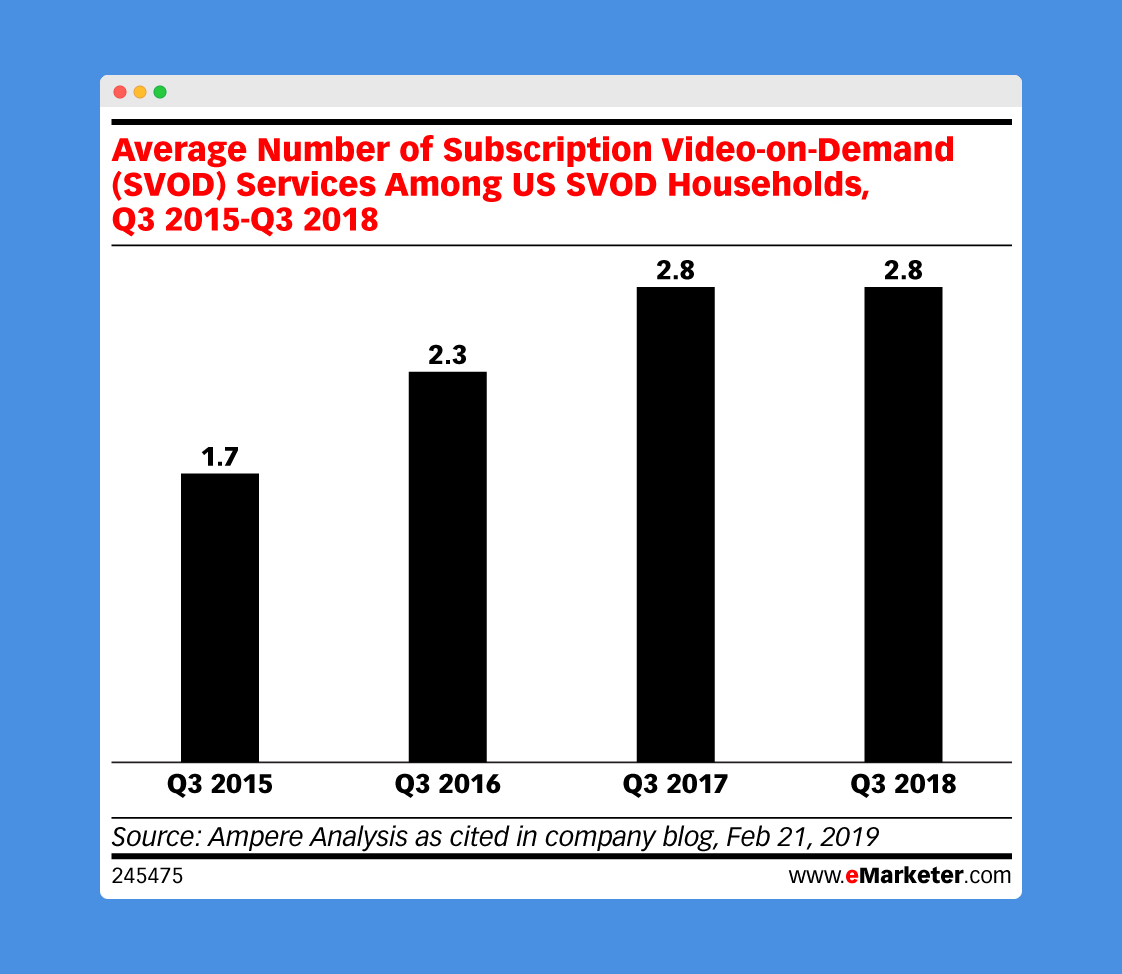
To take a piece of the ever growing video ad pie, several major tech companies and media giants have announced plans to launch streaming services in the years ahead.
One such service is Amazon-owned IMDb's free streaming service called Freedive, which launched in early January 2019. The service offers viewers in the United States access to ad-supported hit TV shows like Without a Trace or The Bachelor, along with Hollywood classics like The Last Samurai, Monster and Awakenings.
In addition, ComCast Corp has pooled together NBCUniversal and British-based Sky to offer advertisers the chance to deliver ads to specific households based on their interests. Largely seen as the future of advertising, this direct-to-consumer streaming service is expected to launch in early 2020 and cost $12 per month.
Already existing streaming services saw significant gains in 2018 as well. For example, Hulu posted almost $1.5 billion in ad revenue for the year, up 45% compared to 2017.
Sling TV reported that ad revenue tripled in 2018 compared to the previous year, while its subscriber base grew 10% to 2.4 million.
Connected TV ad impressions in the United States grew by 44% in Q4 2018, up from 15% growth the year before, according to Extreme Reach.
The rise of mobile
eMarketer's report also dug into some interesting statistics for the rise of mobile. As the report notes:
"Mobile video has been the top growth category in US digital ad spending since 2018 and will remain that way through 2024...mobile video is also far ahead of desktop video in terms of growth rates and dollar volume. It's growth will even outpace every other mobile ad format in that forecast period."
At a time when ad spending on mobile video grew 50% in 2018, ad spending on mobile social grew only 39%, mobile search 33%, and mobile display a mere 14%.
Ad spending on mobile video also outstripped that of desktop video, which grew only 12% in 2018.
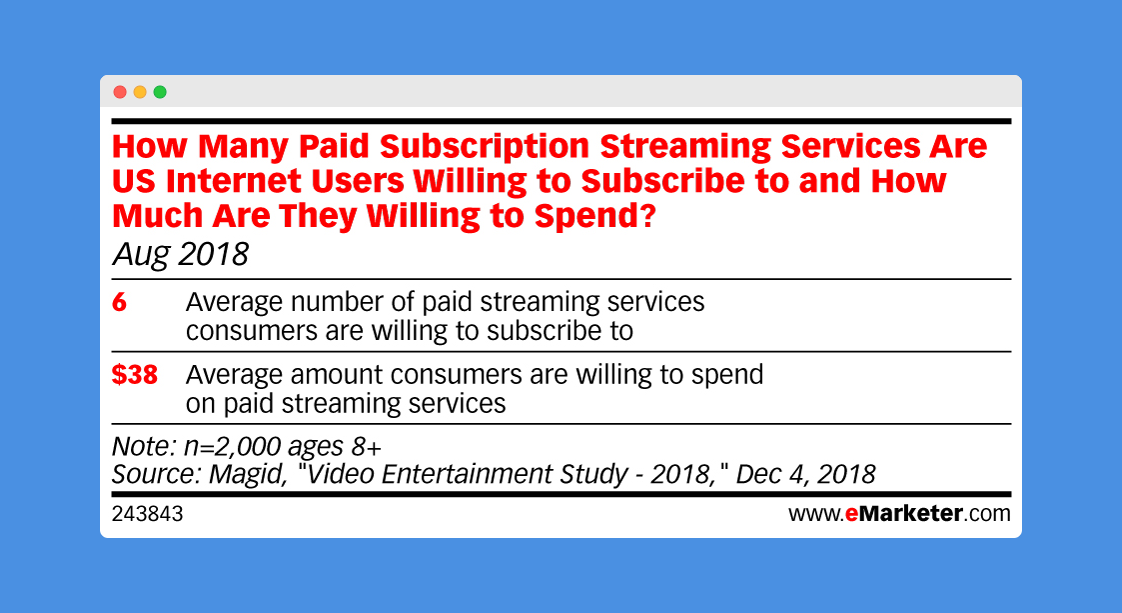
Figures by YouTube highlight support the mobile takeover of the internet, with the platform reporting that 70% of watch time on YouTube takes place on mobile devices.
But despite YouTube's dominant position, the platform underwent severe scrutiny after ads were run on videos that featured children where predators used the comment section to try to target potential victims.
Several major brands stopped advertising on YouTube in response, including AT&T and Nestle.
YouTube has since disabled comments on most videos featuring minors, but despite this, many advertisers have yet to return to the platform.
The rise of OTT services
eMarketer's report also breaks down OTT Services.
Netflix, probably the most popular OTT Service, is expected to spend $15 billion on content in 2019 and $17.8 billion in 2020. In January 2019 the company reached 139 million subscribers, inching toward the 150 million mark.
Similarly Hulu boosted its subscriber base 48% to 25 million in 2018 in the United States, while Hulu Live TV was close to nearing 2 million subscribers, well ahead of YouTube TV which is at 1 million.
The leader for live TV services was Sling TV at 2.4 million.
Most OTT Services raised monthly rates in early 2019. Hulu raised its Live TV monthly rate from $40 to $45 while lowering its ad-supported on-demand tier from $8 to $6.
DirecTV Now raised its mothly rates by $10.
OTT Services are in a competitive marketplace with many operating at a loss as they attempt to scale up their services. As the report quotes: "It's clear that at a $40 per month consumer price point, even achieving breakeven is a challenge."
Netflix announced price increases to its subscriptions as well, hiking the monthly price on its US standard plan by $2 to $13 overall. It also raised the price of its basic plan by $1 to $9.
There is a question of how far consumers are willing to swallow the price increases. Experts downplayed the concerns, indicating that even if there is a slight loss in costumers, most will return in due course.
eMarketer cited a study by Magic that said US Internet were willing to subscribe to up to six streaming services and spend a combined total of $38 per month. "Those numbers suggested that Netflix would effectively be taking a larger share of the total average streaming spend, rather than expanding the value of the marketplace as a whole...which could be problematic for others," eMarketer cited Bloxham as saying.
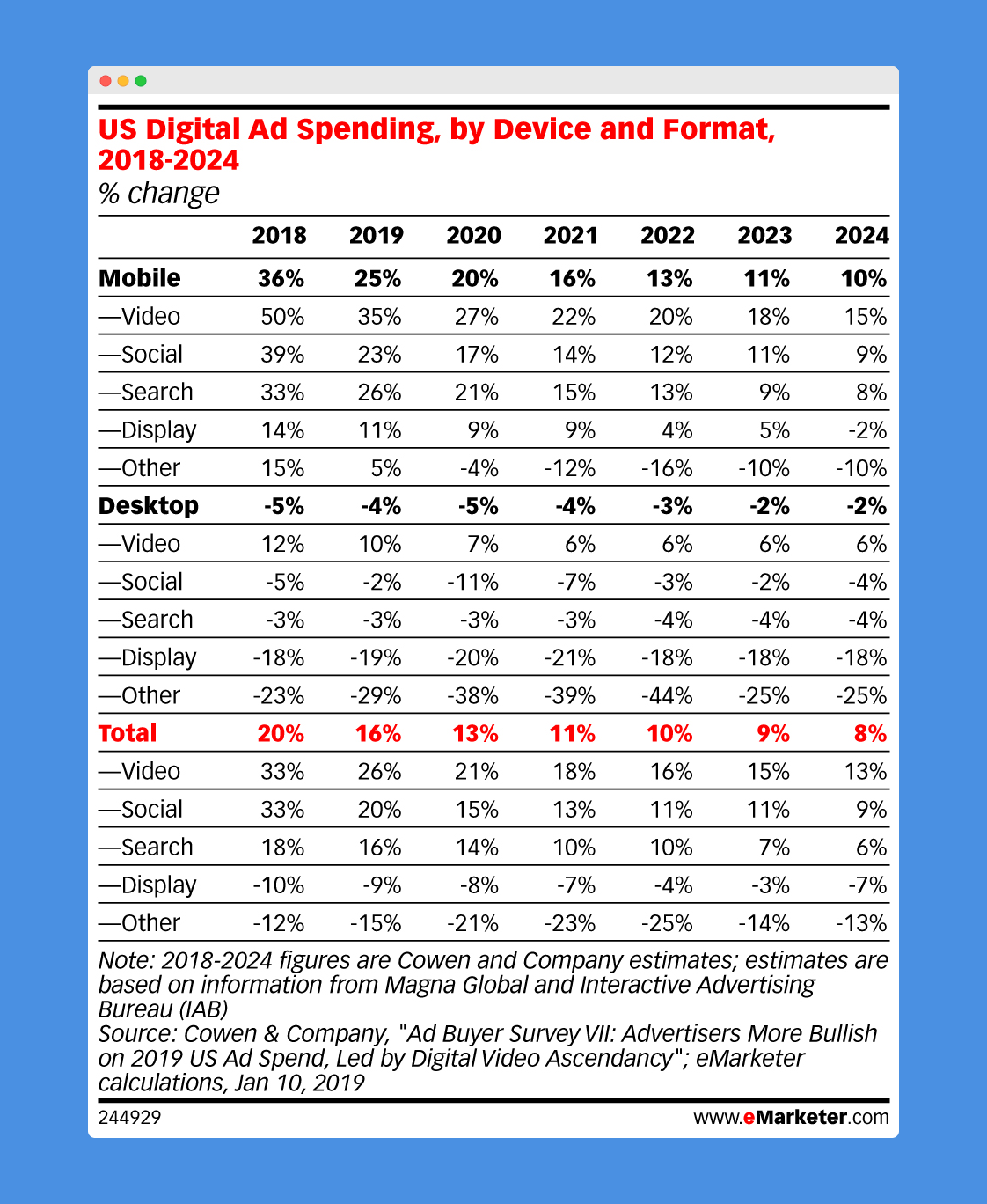
Other studies show that most US households have significantly less streaming services than six.
An Ampere Analysis of US SVOD households found that SVOD subscriptions averaged 2.8 per household, up from 1.7 in 2015. However, the number was stagnant in 2017 and 2018.
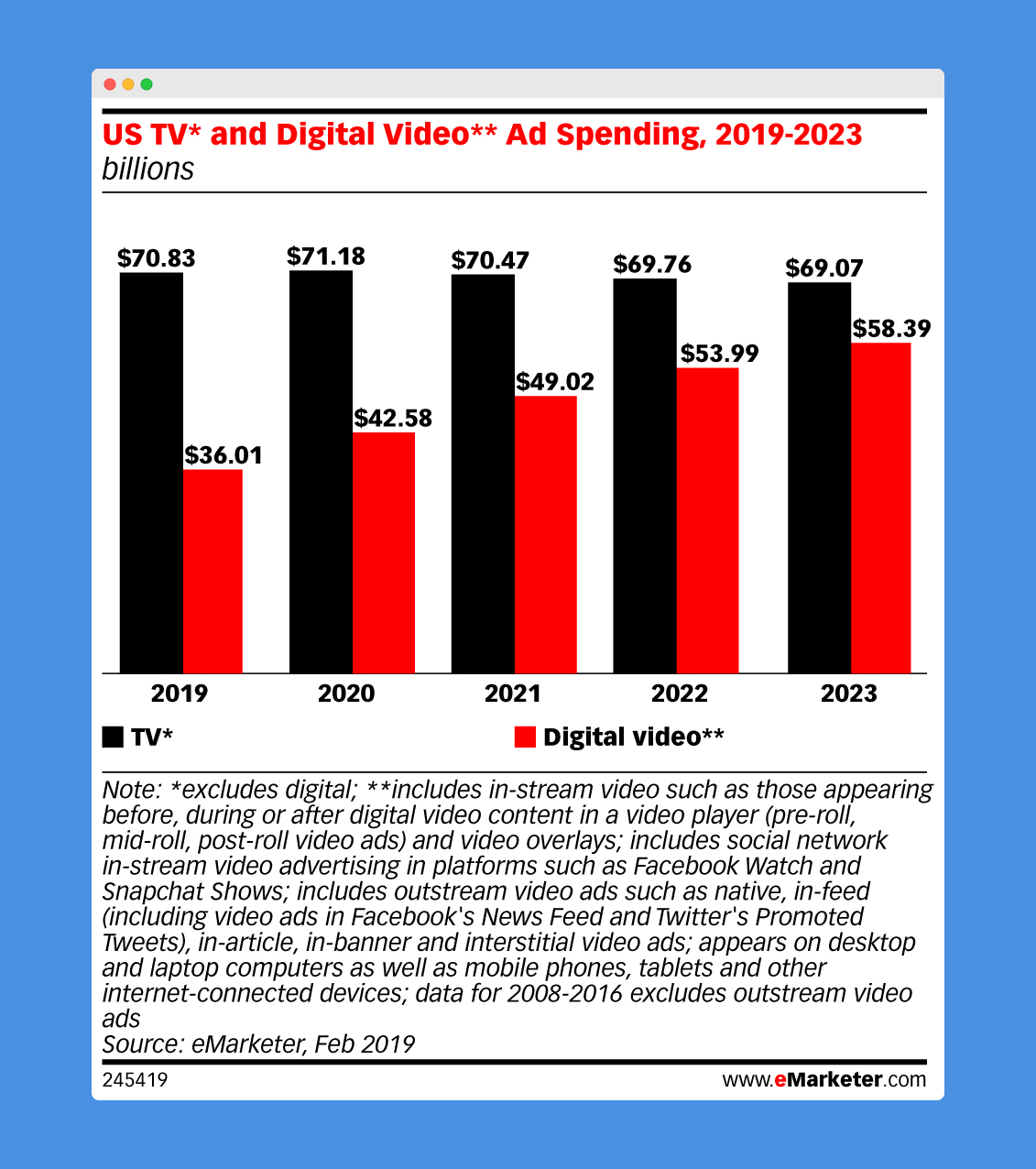
A study by Morning Consult and The Hollywood Reporter found that the acceptable price range for streaming services for US adults was $10-$16 per month for ad-free services and $8-$12 for ad-supported services.
Netflix's monthly subscription is therefore on the upper range, but still acceptable, and the company's price increases will not likely have a major impact on the company as the subscriber base continues to grow.
Netflix reported $4.1 billion in streaming revenue in Q4 2018, an increase of 28.9% year-on-year.
Netflix expands globally
Netflix is dominating the OTT Service industry, and one of the reasons is its expansion abroad.
Whereas before the ratio of the company's subscribers was 60/40 in favor of the United States versus the rest of the world, it is now 60/40 in favor of the rest of the world.
In the past three years, the company has managed to double its worldwide streaming subscribers from 70.8 million in 2015 to 139.3 million in 2019.
In the meantime, it has managed to double its revenue in just two years, posting worlwide revenues of $15.43 billion in 2018, compared to just $8.29 billion in 2016. Most of this revenue now comes from outside the United States.
New challengers to Netflix
In the next twelve months, several competitors to Netflix are set to arise.
These include new streaming services from Disney, Warner Media, NBCUniversal and Apple.
Taken together, this will bring 53 million paying subscriptions to the US market by 2023, an increase of 25%. Revenue from direct-to-consumer video businesses will bring in $3.6 billion in new subscriptions by 2023.
Audience
eMarketer estimates that US digital video viewers will increase by a modest 1.7% to 2.1% over the next four years, reaching 253.3 million in 2023. These growth rates are typical of a category that makes up 80% of internet users.
US live video viewers will reach 123.5 million in 2023, up from 110.7 million in 2019, which means around almost half of US video viewers at least once per month.
US broadband-only households are expected to reach 40.8 million in 2023, an increase of 11.9% from 2018. That means nearly one-third of US households will lack traditional pay TV subscriptions by 2023, mostly due to competitively priced OTT products.
Nearly half of the time Americans watch TV they do so in groups, with 52% watching streaming services and 48% watching through traditional TV.
As many as one in five people in the United States use someone else's account when they watch videos on Netflix, Hulu or Amazon video, which eMarketer says takes a significant hit on revenue. A study by Cordcutting.com estimated that Netflix could be losing as much as $2.3 billion per year because people share their Netflix password with friends.
Platforms
Among the most popular devices for streaming services and to watch video online, Smart TVs took first place for users in North America.
Smart TVs were most popular at 27.1%, followed by game consoles like XBox or PlayStation at 19.4%, Roku at 17.7% and Amazon Fire TV Stick at 15.7%.
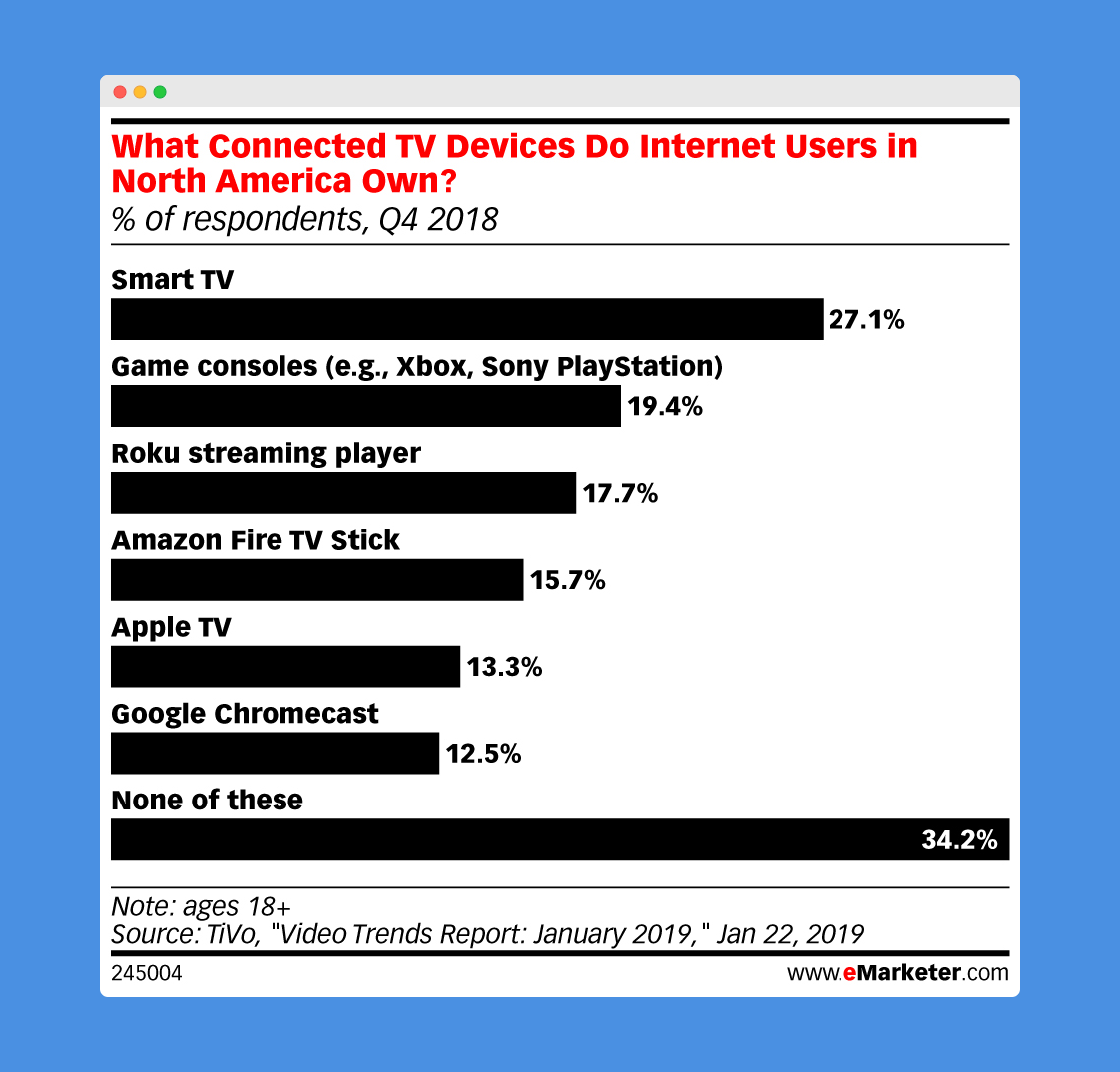
Competitors
Apple
Apple has announced a new television and streaming service, setting itself up for a collision course with Netflix.
The service called Apple TV+ will roll out as an ad-free subscription service, and thus be the latest contender to join the ever expanding streaming wars.
The service will kick off in the autumn, when pricing and availability will be announced.
At its launch event, Apple showed a trailer which featured some of the stars that would be featured in the shows, including Oprah Winfrey, Steven Spielberg and J.J. Abrams.
Apple's bid to branch out in the entertainment industry comes amid a time when iPhone sales are slumping and the company wants to diversify its product range.
Despite not having much experience in television, Apple's music streaming service Apple Music has been a renowned success, reaching 50 million paid subscribers as of 2018.
The company aims to make the viewing process more smooth. In other words, do what Netflix and Amazon do already, but better.
In this regard, it promised the ability to watch ad-free content, watch across devices, download content to watch later, link cable subscriptions to watch live sports and more.
However, Apple's announcement did not come without a fair share of sceptics that raised their doubts.
One problem revolves around content. Where exactly is it going to come from? Without Netflix content, and with Disney aiming to launch its own streaming service later this year, Apple will not have enough content to be the primary streaming service for users, at least as of now.
Secondly, why would Apple's content be somehow unique or better than Netflix's? Apple said it wants to become "a new home for the world's most creative storytellers," but it has offered few details about why exactly their content would be better than that of Netflix.
Finally, Apple is massively behind the competition. It is late to the game and it is unclear whether it is too late.
A good analysis of the situation is provided by Bloomberg in the video below.
Disney
Disney has announced plans to launch its own streaming service in late 2019.
They may be arriving fashionably late, but Disney has so much popular content that it might not matter.
And this presents a direct threat to Netflix's business.
Disney owns Pixar, Marvel, Star Wars, 20th Century Fox which gives the company access to shows like The Simpsons. Not only that, but Disney Movies have become a stable for all children.
Currently, Netflix viewers can enjoy these Disney films if they pay for a Netflix subscription. But once Disney launches its own streaming service Disney+, these shows will disappear from Netflix's network.
This leaves consumers in a tough spot. On the one hand, more streaming services may force streaming providers to keep their monthly subscription rates low. But on the other hand, consumers may be forced to pay for more than one subscription because not all the coontent will be offered on any one subscription.
This creates a major problem for Netflix. As The Verge outlines in its outstanding video on the topic:
"Even if Netflix offered to pay more money in licensing, Disney would rather have you watch their movies on their service."
Amazon
Amazon is a further threat to Netflix and a major player in the streaming wars.
Amazon Prime's video streaming service had 40.12 million subscribers in 2017, and the company plans to boost the figure to 64.08 million in 2020. In just the United States, the number totaled 30.8 million subscribers.
The biggest threat to Netflix is the huge amount of cash the company has that it can burn, totalling $29.77 billion as of September 2018.
Currently Netflix spends around $15 billion on content to pay for the best writers and creators. Amazon has deep pockets, and could be willing to buy up these creators in the future.
Hulu
Although with just 23 to 24 million subscribers, Hulu is a significant threat to Netflix because it is owned by Disney, which controls a vast amount of content that Netflix currently licenses.
Disney could decree that Hulu is the only place to watch classics like Star Wars, or Daredevil or Buffy, or the X-Files, or the X-Men. Fans of these shows will be forced to use Hulu instead of Netflix if they want to see their favorite characters.
In fact, one of the reasons there are more and more Netflix original series is because it is becoming increasingly hard for Netflix to license content from other producers, because these other producers will prefer to keep this content on their own streaming services.
The future of streaming
Given that there are several new contendors on the rise in the near future, video streaming is likely to go one of several routes.
First of all, increasing competitors will likely force Netflix and other subscription services to keep their prices down. In this way consumers will benefit.
On the other hand, the 'golden days of streaming' where you could find virtually all the content you want on only one streaming service may end.
Consumers will likely have to subscribe to multiple streaming services in order to get all the content they need.
This means, what is likely to happen is bundle services will begin to arrive that group several streaming services together and sell a package, similar to cable packages.
Consumers simply won't be able to shell out $10 or more for subscription services to several online streamers to get the content they want.
Another consequence will mean that piracy will become more popular. People may decide to subsribe to one service and then pirate the rest of their videos.
Also, due to the high costs of creating content, it is questionable how long these different online streaming services will offer ad-free subscriptions.
Given the tight margins in the industry already, and how expensive good content is to produce, it is quite possible that ad-free subscription services will not exist and that consumers will be forced to watch ads with any subcription service they choose to use.
Try Aori
Want to save time managing your PPC campaigns? Check out our smart advertising solutions to see how they can help you save time on your PPC campaigns.
